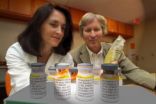By a conservative estimate, something like 1,000 different varieties of microbes coexist harmoniously within a typical healthy person's gut, said David Relman, MD, professor of medicine and of microbiology and immunology at the medical school and chief of the infectious diseases division at the Veterans Affairs Palo Alto Health Care System. Relman is the senior author of a paper, which will appear online Sept. 13 in Proceedings of the National Academy of Sciences.
The study examined the effects of ciprofloxacin (trade name Cipro), an antibiotic that is widely prescribed for intestinal, urinary and a variety of systemic infections. In an earlier, short-term study, Relman's group had concluded that people's intestinal microbial communities seem to bounce back reasonably well within weeks after a five-day regimen of ciprofloxacin. This new study involved two courses of antibiotic administration, six months apart, and it revealed more-subtle, long-term effects of ciprofloxacin use - such as the replacement of multiple resident bacterial species by other, closely related varieties and the occasional complete eradication of a species.
The infrequent occurrence of easily visible side effects such as bloating and diarrhea from ciprofloxacin use has given rise to an assumption that the drug spares most beneficial gut-dwelling bacteria. Overall similarities between pre-regimen gut bacterial strains and their post-regimen replacements explain why such side effects aren't typically seen after ciprofloxacin use. Still, the more nuanced differences between the pre-existing communities and those that appear in the wake of this repeated disturbance present a new set of problems, said Relman, who is also the Thomas C. and Joan M. Merigan Professor at the medical school. A bacterial species whose presence was lost or diminished may have been performing a valuable job - for example, secreting a protein that's toxic to a particular pathogen - that is shirked by its replacement. The abandoned function might not be noticed until, perhaps, years later when the pathogen in question invaded the person's gut.
While the study's findings shouldn't be interpreted to mean that ciprofloxacin is dangerous and should be avoided, Relman said, they do raise questions about possible long-term effects of antibiotic administration, in addition to concerns about spurring the evolution of drug-resistant organisms. The new findings underscore the desirability of finding ways to pinpoint not just which bacteria have been lost or whose numbers were diminished by an antibiotic, but also which important beneficial functions performed by the patient's gut microbial community as a whole have been impaired - such as signaling cells of the intestinal lining, which are constantly turning over, to maintain an appropriate barrier against ingested toxic compounds, or secreting anti-inflammatory substances that may prevent allergic or autoimmune diseases.
For this study, the Stanford scientists collected more than 50 stool samples from each of three healthy adult females over a period of 10 months. Then they used advanced, molecular techniques to count the number of different microbial species represented in each sample, as well as relative population sizes of the different species in that sample.
Twice during this 10-month period, the researchers perturbed their subjects' gut ecosystems by giving them five-day courses of ciprofloxacin at a standard dose. During the first course, overall bacterial populations in each subject - which had previously waxed and waned but, on the whole, been quite stable - plummeted and remained depressed for about a week. Roughly one-third to one-half of the resident species' populations declined, with some disappearing entirely. A few originally less-abundant species grew in number, as they filled in the ecological niche abandoned by bugs adversely affected by the drug.
Within a week after the first course's completion, two of the three subjects' internal microbial ecosystems had largely returned to a state fairly similar to that before the regimen, as measured by the broad classes to which the microbial constituents belonged. One subject's overall ecosystem, however, still had not recovered even by that rough measure a full six months later.
The second course of antibiotic administration produced a stronger effect. "Even the one subject whose gut bacterial community fully recovered after the first ciprofloxacin course experienced an incomplete recovery after the second one," said Relman. The communities in the other two subjects partially recovered from the second course, but never returned to their original state. In essence, each subject's community of gut-dwelling microbes shifted to a new, "alternative" state and remained in that state for at least two months after the second antibiotic course had been completed. Thus, all three subjects experienced significant and lasting changes in the specific membership of their internal microbial communities at the end of the 10-month study period.
"Ecologists have found that an ecosystem, such as a wildlife refuge, that is quite capable of rebounding from even huge occasional perturbations - forest fire, volcanic eruption, pests - may yet be undone by too rapid a series of such perturbations," said Les Dethlefsen, PhD, a research scientist in Relman's lab and the study's first author. "In the same way, recurring antibiotic use may produce a cumulative effect on our internal microbial ecosystems with potentially debilitating, if as yet unpredictable, consequences."
"It's as if your beneficial bacteria 'remember' the bad things done to them in the past," said Relman. "Clinical signs and symptoms may be the last thing to show up."
The precise counts of gut-dwelling microbes in this study were made possible by a new technique, pioneered in recent years by Relman and others. The older method - growing the microbes in culture - simply doesn't work for many species and, even when it does, rare species are often swamped by more common ones and don't get counted. The new technique reads short, telltale DNA snippets that distinguish microbes both from human cells and one from another. This allowed the Stanford researchers to assess both the total number of different microbial varieties and the relative size of each variety's population.
Similar techniques now make it possible to assess, before and after antibiotic administration, the abundance in a patient's gut of microbial genes known to code for important functions performed by one or more members of the patient's gut community, Relman said. In the future, if it becomes known that a key function has been impaired, clinicians might perhaps restore that function by prescribing specific probiotics or nutrients that encourage the return of appropriate beneficial bugs.
###
The research was supported by a National Institutes of Health Pioneer Award and by the Doris Duke Charitable Foundation. More information about the Departments of Medicine and of Microbiology and Immunology, which also supported the research, is available at http://medicine.stanford.edu and http://microimmuno.stanford.edu.
The Stanford University School of Medicine consistently ranks among the nation's top medical schools, integrating research, medical education, patient care and community service. For more news about the school, please visit http://mednews.stanford.edu. The medical school is part of Stanford Medicine, which includes Stanford Hospital & Clinics and Lucile Packard Children's Hospital. For information about all three, please visit http://stanfordmedicine.org/about/news.html.
END

